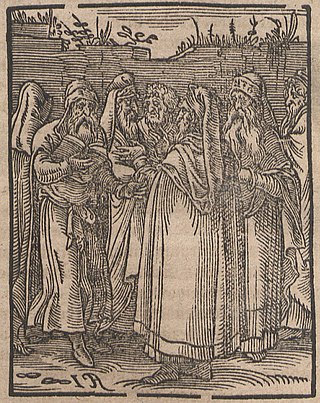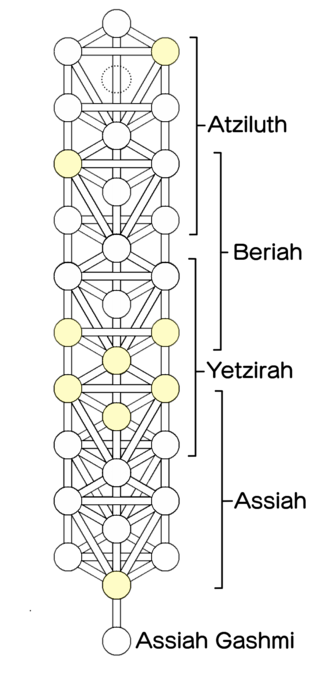
Kabbalah or Qabalah is an esoteric method, discipline and school of thought in Jewish mysticism. A traditional Kabbalist is called a Mekubbal. The definition of Kabbalah varies according to the tradition and aims of those following it, from its origin in medieval Judaism to its later adaptations in Western esotericism. Jewish Kabbalah is a set of esoteric teachings meant to explain the relationship between the unchanging, eternal God—the mysterious Ein Sof —and the mortal, finite universe. It forms the foundation of mystical religious interpretations within Judaism.

Panentheism is the belief that the divine intersects every part of the universe and also extends beyond space and time. The term was coined by the German philosopher Karl Krause in 1828 to distinguish the ideas of Georg Wilhelm Friedrich Hegel (1770–1831) and Friedrich Wilhelm Joseph Schelling (1775–1854) about the relation of God and the universe from the supposed pantheism of Baruch Spinoza. Unlike pantheism, which holds that the divine and the universe are identical, panentheism maintains an ontological distinction between the divine and the non-divine and the significance of both.

The Tanya is an early work of Hasidic philosophy, by Rabbi Shneur Zalman of Liadi, the founder of Chabad Hasidism, first published in 1796. Its formal title is Likkutei Amarim, but is more commonly known by its first Hebrew word tanya, which means "it has been taught", where he refers to a baraita section in "Niddah", at the end of chapter 3, 30b. Tanya is composed of five sections that define Hasidic mystical psychology and theology as a handbook for daily spiritual life in Jewish observance.
Academic study of Jewish mysticism, especially since Gershom Scholem's Major Trends in Jewish Mysticism (1941), draws distinctions between different forms of mysticism which were practiced in different eras of Jewish history. Of these, Kabbalah, which emerged in 12th-century southwestern Europe, is the most well known, but it is not the only typological form, nor was it the first form which emerged. Among the previous forms were Merkabah mysticism, and Ashkenazi Hasidim around the time of the emergence of Kabbalah.
The tzimtzum or tsimtsum is a term used in the Lurianic Kabbalah to explain Isaac Luria's doctrine that God began the process of creation by "contracting" his Ohr Ein Sof in order to allow for a "conceptual space" in which finite and seemingly independent realms could exist. This primordial initial contraction, forming a ḥalal hapanuy "vacant space" into which new creative light could beam, is denoted by general reference to the tzimtzum. In Kabbalistic interpretation, tzimtzum gives rise to the paradox of simultaneous divine presence and absence within the vacuum and resultant Creation. Various approaches exist then, within Orthodoxy, as to how the paradox may be resolved, and as to the nature of tzimtzum itself.

Sefirot, meaning emanations, are the 10 attributes/emanations in Kabbalah, through which Ein Sof reveals itself and continuously creates both the physical realm and the chain of higher metaphysical realms. The term is alternatively transliterated into English as sephirot/sephiroth, singular sefirah/sephirah.

In the branch of Jewish mysticism known as Kabbalah, Daʻat or Da'ath is the location where all ten sefirot in the Tree of Life are united as one.
Ein Sof, or Eyn Sof, in Kabbalah, is understood as God prior to any self-manifestation in the production of any spiritual realm, probably derived from Solomon ibn Gabirol's term, "the Endless One". Ein Sof may be translated as "unending", "(there is) no end", or infinity. It was first used by Azriel, who, sharing the Neoplatonic belief that God can have no desire, thought, word, or action, emphasized by it the negation of any attribute. Of the Ein Sof, nothing ("Ein") can be grasped ("Sof"-limitation). It is the origin of the Ohr Ein Sof, the "Infinite Light" of paradoxical divine self-knowledge, nullified within the Ein Sof prior to creation. In Lurianic Kabbalah, the first act of creation, the Tzimtzum self "withdrawal" of God to create an "empty space", takes place from there. In Hasidic Judaism, the Tzimtzum is only the illusionary concealment of the Ohr Ein Sof, giving rise to monistic panentheism. Consequently, Hasidism focuses on the Atzmus divine essence, rooted higher within the Godhead than the Ein Sof, which is limited to infinitude, and reflected in the essence (etzem) of the Torah and the soul.
In philosophy, transcendence is the basic ground concept from the word's literal meaning, of climbing or going beyond, albeit with varying connotations in its different historical and cultural stages. It includes philosophies, systems, and approaches that describe the fundamental structures of being, not as an ontology, but as the framework of emergence and validation of knowledge of being. These definitions are generally grounded in reason and empirical observation and seek to provide a framework for understanding the world that is not reliant on religious beliefs or supernatural forces. "Transcendental" is a word derived from the scholastic, designating the extra-categorical attributes of beings.
In religion, transcendence is the aspect of existence that is completely independent of the material universe, beyond all known physical laws. This is related to the nature and power of deities as well as other spiritual or supernatural beings and forces. This is contrasted with immanence, where a god is said to be fully present in the physical world and thus accessible to creatures in various ways. In religious experience, transcendence is a state of being that has overcome the limitations of physical existence, and by some definitions, has also become independent of it. This is typically manifested in prayer, rituals, meditation, psychedelics and paranormal "visions".
Pardes (פרד"ס) is a Kabbalistic theory of Biblical exegesis first advanced by Moses de León, adapting the popular "fourfold" method of medieval Christianity. The term, sometimes also rendered PaRDeS, means "orchard" when taken literally, but is used in this context as a Hebrew acronym formed from the initials of the following four approaches:
In Kabbalistic and Hasidic philosophy, seder hishtalshelut or hishtalshelus refers to the chain-like descent of spiritual worlds (Olam/Olamot) between God and Creation. Each spiritual world denotes a complete realm of existence, resulting from its general proximity or distance to divine revelation. Each realm is also a form of consciousness reflected in this world through the psychology of the soul.
Lurianic Kabbalah is a school of Kabbalah named after Isaac Luria (1534–1572), the Jewish rabbi who developed it. Lurianic Kabbalah gave a seminal new account of Kabbalistic thought that its followers synthesised with, and read into, the earlier Kabbalah of the Zohar that had disseminated in Medieval circles.

The Four Worlds, sometimes counted with a prior stage to make Five Worlds, are the comprehensive categories of spiritual realms in Kabbalah in the descending chain of Existence.
Ohr is a central Kabbalistic term in Jewish mysticism. The analogy of physical light is used as a way of describing metaphysical divine emanations. Shefa "flow" (שפע) and its derivative, hashpoah "influence" השפעה), are sometimes alternatively used in Kabbalah, a term also used in Medieval Jewish philosophy to mean divine influence, while the Kabbalists favour Ohr because its numerical value equals ר״ז, a homonym for רז rāz "mystery". It is one of the two main metaphors in Kabbalah for understanding God, along with the other metaphor of the human soul-body relationship for the sefirot.
Ayin is an important concept in Kabbalah and Hasidic philosophy. It is contrasted with the term Yesh. According to kabbalistic teachings, before the universe was created there was only Ayin, the first manifest Sephirah ,and second sephirah Chochmah (Wisdom), "comes into being out of Ayin." In this context, the sephirah Keter, the Divine will, is the intermediary between the Divine Infinity and Chochmah. Because Keter is a supreme revelation of the Ohr Ein Sof, transcending the manifest sephirot, it is sometimes excluded from them.
Atzmus or Atzmut is the descriptive term referred to in Kabbalah, and explored in Hasidic thought, for the divine essence.

Kochos/Kochot haNefesh, meaning "Powers of the Soul", are the innate constituent character-aspects within the soul, in Hasidic thought's psychological internalisation of Kabbalah. They derive from the 10 Sephirot Heavenly emanations of Kabbalah, by relating each quality to its parallel internal motivation in man. The Hasidic discussion of the sephirot, particularly in the Kabbalistically oriented system of Habad thought, focuses principally on the Soul Powers, the experience of the sephirot in Jewish worship.
Kabbalah, the central system in Jewish mysticism, uses anthropomorphic mythic symbols to metaphorically describe manifestations of God in Judaism. Based on the verses "God created man in his own image, in the image of God created he him; male and female created he them" and "from my flesh shall I see God", Kabbalah uses the form of the human body to describe the structure of the human soul, and the nature of supernal Divine emanations. A particular concern of Kabbalah is sexual unity between male and female potencies in Divinity on high, depicted as interaction of the two sides in the sephirot, between archetypal partzufim, and the redemption of the exiled Shekhinah from captivity among the impure forces below.

The concepts and structures of Jewish Kabbalah have been used in the contemporary world to open comparative dialogue and cross-fertilization with modern secular disciplines in the Sciences and Humanities. This has been an uncommon phenomenon, since it requires wide internal understanding of both traditionalist Kabbalah and modern secular thought, and for social reasons Jewish modernity has seen isolation and entrenchment between the two. Skilled authorities in both traditions have included contemporary traditionalist Orthodox teachers of Kabbalah, as well as Neo-Kabbalistic and Academic scholars who read Kabbalah in a critical, universalist way.







